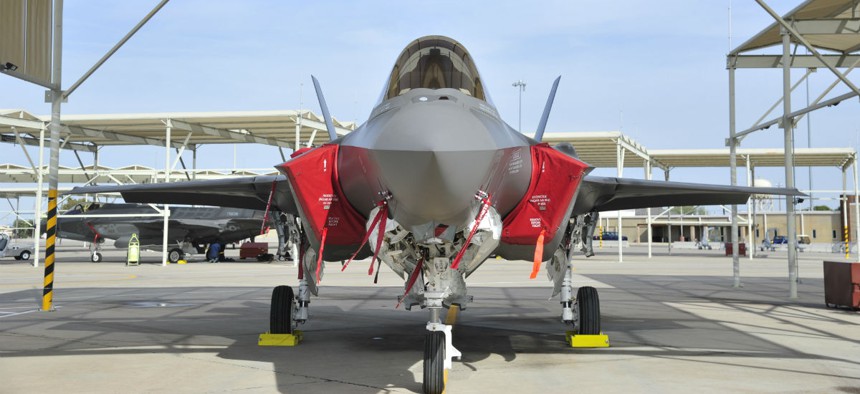F-35 Joint Fighter Program Flies Through Flak from Watchdogs
House defense bill continues investment despite questions on engine reliability.
The F-35 joint strike fighter, already the most expensive U.S. weapons system ever, took hits last month from two government watchdogs, but it does not appear to have been thrown off course.
A Defense Department inspector general critique of the reliability of the complex aircraft’s engine, following a broader Government Accountability Office report anticipating continuing delays, has not discouraged lawmakers from pressing ahead with two-decade-old plans for the $400 billion fleet of planes for use by several services.
The Pentagon watchdog, in an April 27 report on quality management for the F-35 Lightning II being manufactured chiefly by Lockheed Martin and Pratt & Whitney, found 61 “nonconformities,” or violations of regulatory requirements affecting engine issues such as software. Oversight by the department’s Joint Program Office was deemed insufficient, and safety requirements were not met in areas such as parts and supplier identification. The program office “did not ensure that Pratt & Whitney proactively identified, elevated, tracked, and managed [engine] program risks, in accordance with the [engine program] risk management plan,” the IG found.
Auditors made 13 recommendations, among them that the program office coordinate with the Defense Contract Management Agency to conduct a “root cause analysis” and “ensure that all associated data required to substantiate corrective action closure are accessible, available, and retrievable.”
The Defense Department agreed with all but four recommendations.
GAO, in an April 14 report and testimony, said the overall program “continued to experience development and testing discoveries over the past year, largely due to a structural failure on the F-35B durability test aircraft, an engine failure, and more test point growth due to software challenges than expected.” Warning of more delays, the congressional watchdog noted “mixed supplier performance” and said the 36 units delivered in 2014 lacked warfighting capabilities. “The F-35 engine reliability is not improving as expected and will take additional time and resources to achieve reliability goals,” GAO said.
The auditors credited the contractors with reducing labor hours needed for manufacturing. But they warned that the Pentagon’s plan to invest $54 billion over the next five years may not render the weapons under the current procurement plan “affordable.”
The reaction at Defense, on Capitol Hill and among contractors was to press ahead. “The program must continue to drive the cost of producing F-35s down, and must continue to attack the long-term life-cycle costs of the F-35 weapon system,” said program executive officer Lt. Gen. Christopher Bogdan, in co-authored testimony delivered April 14 to a House Armed Services subcommittee. “To that end, the program has engaged in a multi-pronged approach to reduce costs across production, operations and support,” he said.
Bogdan cited an agreement with partners Lockheed Martin, Northrup Grumman and BAE Systems called “Blueprint for Affordability” along with a Pratt & Whitney effort called “War on Costs” intended to cut the spend on a single copy of the plane by $80 million to $85 million by 2019.
Pratt & Whitney in April called a press conference to pronounce its engines “reliable.” And the full House committee during an April 27 markup rejected a proposal by Rep. Jackie Speier, D-Calif., to cut six F-35s from the current order of 44 to save $589 million, according to news accounts. (The Senate Armed Services Committee has markups scheduled for the week of May 11.)
As the House committee report on the National Defense Authorization bill put it, “The committee continues to strongly support the requirement for fifth generation fighter aircraft due to projected increases in the effectiveness and quantities of threat anti-aircraft ground systems and adversary aircraft and their associated air-to-air weapons. The committee believes that without advanced fifth- generation aircraft, the United States may be significantly limited in its ability to project power in the future.”
The watchdog critiques “were not that serious,” Todd Harrison, senior fellow in defense budget studies at the nonprofit Center for Strategic and Budgetary Assessments, told Government Executive. “GAO was looking at total reliability assessments for a pool of engineer reliability in all engines produced. The issue really is that the first engine off the production line did have big reliability issues with maintenance. But Pratt and Whitney has learned and made fixes, so the more recent engines off the production line have much more reliability. That’s why we do the tests.”
In the long run, Harrison said, “the issue is concurrency,” the way the F-35 was moved into production before adequate progress in research and development, which slowed the program down. “The lesson that the DoD and the services should have learned, but apparently have not, is that concurrency is bad for programs,” he said, expressing hope that managers planning the procurement of future major weapons, such as the Long Range Strike Bomber, learn that lesson.
NEXT STORY: The Pentagon Gets Two New Top Generals




